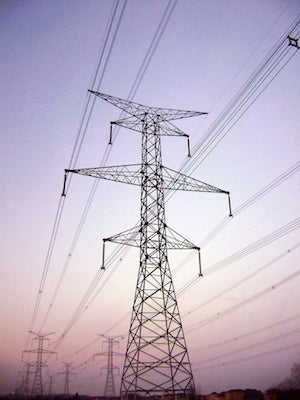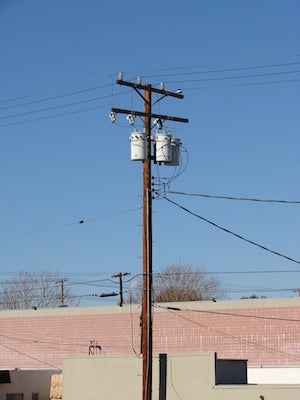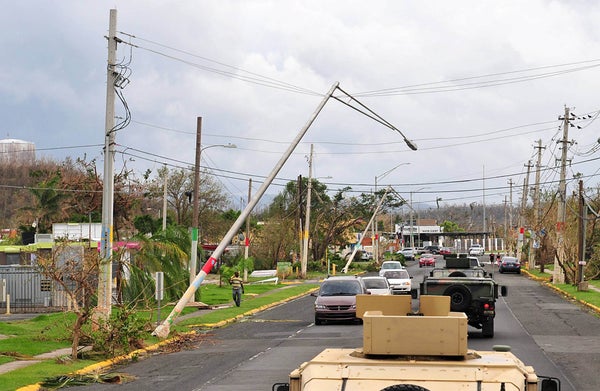This article was published in Scientific American’s former blog network and reflects the views of the author, not necessarily those of Scientific American
Since hurricane Maria struck the U.S. territory of Puerto Rico last week, the island has been in the midst of an escalating humanitarian crisis driven by near-complete loss of electricity across the island. Preliminary reports and damage assessments suggest it could take up to several months to fully restore service to the island. But it’s hard to tell at this point.
There is an urgent need to assess and repair Puerto Rico’s electric grid not only to return electricity service to vital facilities such as hospitals and clinics, but also to restore power to other critical infrastructure such as water distribution, wastewater treatment, and communication.
Based on preliminary assessments of the damage to Puerto Rico’s grid, the outage is largely caused by massive damage to the island’s network of transmission and distribution lines. According to Public Affairs Secretary Ramon Rosario, Hurricane Maria knocked down approximately 80 percent of the islands transmission and distribution lines — a massive blow that will require a large-scale deployment of utility workers to repair.
On supporting science journalism
If you're enjoying this article, consider supporting our award-winning journalism by subscribing. By purchasing a subscription you are helping to ensure the future of impactful stories about the discoveries and ideas shaping our world today.
Puerto Rico’s Electricity Backbone is Broken

Credit: Ian Muttoo Flickr (CC BY-SA 2.0)
High-voltage transmission lines are the backbone of any electricity system. They are the electric “highways” of the power grid that bring electricity from power plants to lower-voltage distribution lines, the electric “roads” that pipe power into residential and commercial buildings. While distribution lines are typically built in a hierarchical or radial structure, where one failure causes total loss of power downstream, transmission lines are built in a complex and redundant network with several areas of redundancy that allow power to continue flowing even if one or more line suddenly goes down. Transmission lines are built in this way because of how vital the bulk power they carry is to the rest of the electrical system.
Puerto Rico suffered major damage to its transmission network. Because these lines makeup the backbone of the electricity system, the grid as a whole won’t be up and running again until enough transmission lines are up to carry power between major power plants and population centers — and that could take months. According to Ken Buell, director of Emergency Response and Recovery with the U.S. Department of Energy, many of Puerto Rico’s transmission lines run long distances over mountains, so making repairs will not be an easy task.
Electricity Distribution is “Near 100 Percent” Damaged

Credit: Gareth Simpson Flickr(CC BY 2.0)
While the damage to Puerto Rico’s transmission network is what brought down the island’s grid as a whole, electricity service will not be restored until lower-voltage distribution lines are also repaired. Even if the bulk power system were back online in Puerto Rico, electricity service could not be restored to individual buildings until the distribution lines linking buildings to the bulk transmission network were repaired.
According to Buell, the local power authority hasn’t finished assessing the damage to power lines that run from distribution centers to homes and businesses, “but they’re assuming it’s near 100 percent.”
Fully repairing the island’s distribution lines will be a monumental task. While distribution lines are less vital than the transmission lines that makeup the backbone of the grid, there are a lot more of them. The Puerto Rico Electric Power Authority, or PREPA, has some 2,400 miles of major transmission lines, but over 30,000 miles of smaller distribution lines.
What Can We Do for Puerto Rico?
Electric utility workers from outside Puerto Rico have already arrived on the island to begin repairs to the its crippled electrical grid. The American Public Power Association, which represents PREPA and other publicly-owned power authorities throughout the United States, has been working to bring the expertise and manpower needed for assessments and repairs. The State of New York has also stepped up in a big way, flying in large-scale backup generators, bottled water, ready-to-eat meals, and a team of transmission engineers and drone pilots.
If you’d like to do something to help residents of Puerto Rico, you can donate money to an aid organization, donate emergency and construction supplies, or volunteer. You can find a full list of ways to contribute here.
In the long term, there is also an opportunity for the federal government to help rebuild Puerto Rico’s electricity infrastructure in a way that will lessen the impact of future hurricanes. It took four months to restore power to the entire island after Hurricane Hugo in 1989 and six months after Hurricane Georges in 1998, so the prudent thing to do is make investments now that will prevent a future crisis. From relatively simple measures like undergrounding transmission and distribution lines to more complex efforts like redesigning the island’s power network to include microgrids capable of operating in isolation, there are numerous ways the federal government could mitigate the impacts of future storms — and lessons learned from those efforts could be used to inform grid resiliency efforts across the United States.
